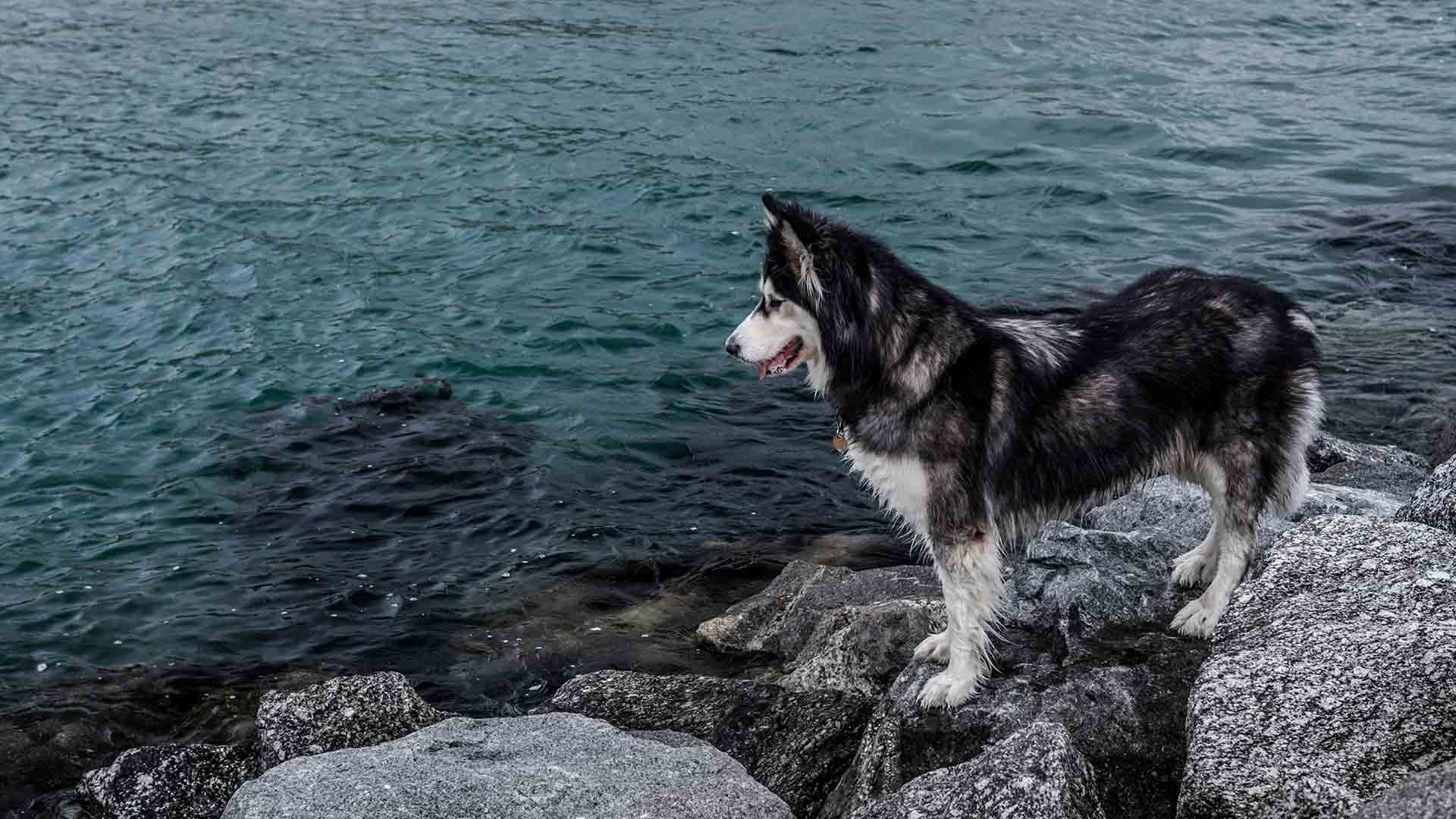Are you a proud owner of a husky? If so, you probably already know how important it is to keep your energetic furry friend properly exercised. But have you ever considered swimming as a form of exercise for your husky? Not only is swimming a fun and refreshing activity for these arctic dogs, but it also provides numerous safety and health benefits. In this article, we will explore the safety precautions to take when introducing your husky to swimming and delve into the incredible benefits that this water exercise can offer for their overall well-being. So grab your towel and get ready to dive into the world of swimming as exercise for huskies!
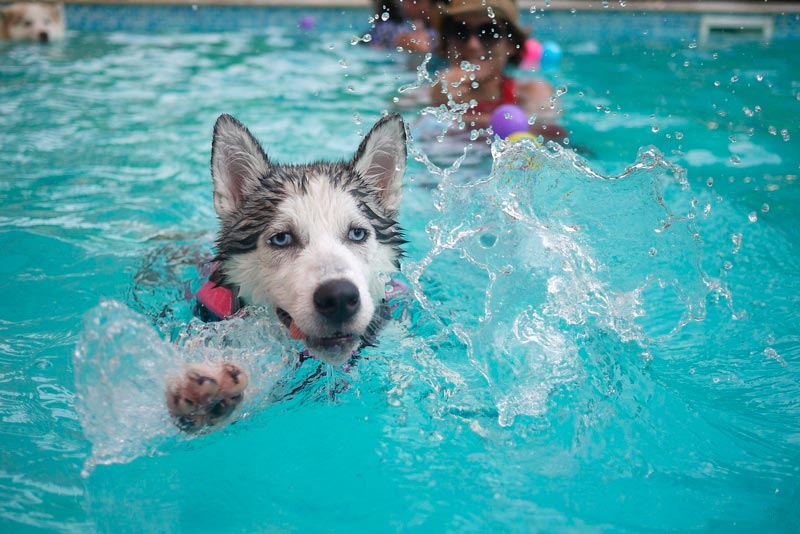
Safety Precautions for Swimming
Swimming is a wonderful form of exercise for Huskies, but it’s important to ensure their safety and well-being during water activities. By following these safety precautions, you can enjoy swimming with your Husky while keeping them protected.
Understanding Huskies’ Physical Abilities
Before diving into swimming with your Husky, it’s crucial to understand their physical abilities. Huskies are natural swimmers thanks to their water-resistant double coat and webbed paws, which help them paddle through the water efficiently. However, it’s important to note that not all Huskies are natural swimmers, and some may require more guidance and training.
Supervision and Monitoring
Never leave your Husky unattended while swimming. Always keep a vigilant eye on them to ensure their safety. Even though they have physical abilities that make them good swimmers, accidents can happen. By being present and attentive, you can quickly respond to any potential dangers and prevent accidents.
Water Temperature and Quality
Maintain an ideal water temperature for your Husky’s safety and comfort. Cold water can lead to hypothermia, while overly warm water can cause overheating. Moreover, be aware of the water quality to avoid any potential health hazards, such as algae blooms or contaminated water sources. Always choose clean and clear water for your Husky’s swimming activities.
Swimming Skills and Training
While some Huskies take to swimming naturally, others may need assistance and training in acquiring swimming skills. Teach them how to enter and exit the water safely, as well as proper swimming techniques. Patience, encouragement, and positive reinforcement are key in helping your Husky become a confident swimmer.
Proper Use of Safety Equipment
Invest in appropriate safety equipment for your Husky when swimming. Swim vests or life jackets are highly recommended, especially for inexperienced swimmers or those who may struggle in deep water. These devices provide extra buoyancy and can potentially save their lives in case of an accidental fall or fatigue. Ensure that the safety equipment fits properly and does not restrict your Husky’s movements.
Benefits of Swimming for Huskies
Swimming offers numerous benefits to Huskies and contributes to their overall well-being. Let’s take a closer look at some of the advantages of swimming as an exercise for Huskies.
Low-Impact Exercise
Swimming is a low-impact exercise that is gentle on joints and provides a great cardiovascular workout. It helps Huskies burn calories and stay fit without putting excessive strain on their bodies. This makes swimming an excellent exercise option for Huskies with joint issues, arthritis, or other mobility limitations.
Muscle Strengthening and Conditioning
Swimming engages a wide range of muscles in a Husky’s body, including the core, legs, and shoulders. By regularly swimming, Huskies can strengthen and tone their muscles, improving their overall physical strength and endurance. Strong muscles play a crucial role in maintaining proper posture, balance, and movement.
Cardiovascular Health
Swimming is a fantastic way to improve cardiovascular health in Huskies. It increases heart rate, improves circulation, and enhances lung capacity. Regular swimming sessions can help prevent heart disease, improve stamina, and keep your Husky’s cardiovascular system in excellent condition.
Weight Management
Many Huskies struggle with weight management due to their hearty appetites and genetic predispositions. Swimming provides a highly effective way to burn calories and maintain a healthy weight. Combined with a balanced diet, swimming can assist in managing weight and preventing obesity-related health issues.
Joint and Bone Health
Huskies are prone to joint and bone problems, especially as they age. Swimming is a non-weight-bearing exercise that reduces stress on joints and minimizes the impact on bones. The buoyancy of water supports the Husky’s body, relieving pressure on joints and allowing for gentle, pain-free movement.
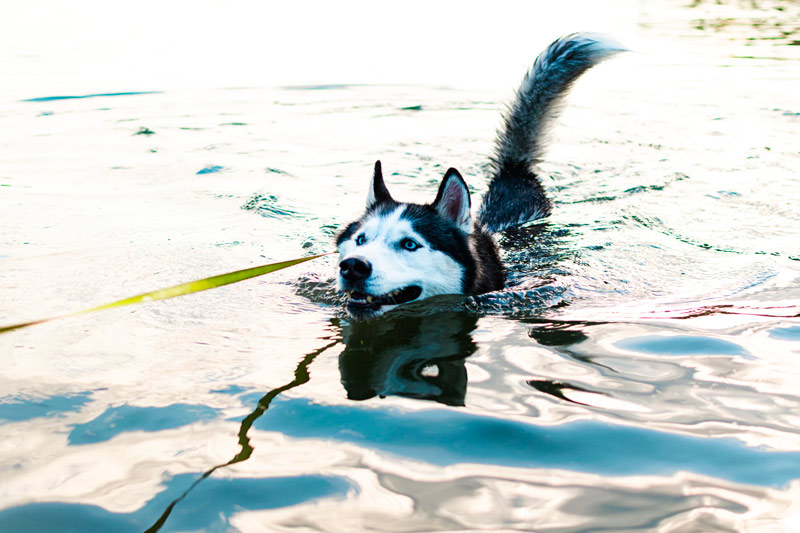
Swimming Techniques for Huskies
To ensure a safe and enjoyable swimming experience for your Husky, it’s important to introduce them to the water gradually and teach them necessary swimming skills. Here are some tips on swimming techniques for Huskies.
Introducing Huskies to Water
Not all Huskies will immediately take to the water, so it’s essential to introduce them gradually. Start by letting them explore shallow water and get comfortable with their paws wet. Use positive reinforcement, treats, and toys to create a positive association with water. Gradually increase their exposure to deeper water, always keeping a watchful eye and providing support as needed.
Teaching Basic Swimming Skills
Begin by teaching your Husky basic swimming skills in a controlled and safe environment. Support them under their belly and encourage them to paddle their legs while keeping their head above water. Be patient and supportive during the learning process, praising and rewarding your Husky for their efforts. Gradually reduce your support as they gain confidence and become comfortable swimming independently.
Advanced Swimming Techniques
Once your Husky has acquired basic swimming skills, you can introduce more advanced techniques. Teach them different strokes, such as the doggy paddle or freestyle, to enhance their swimming abilities. Advanced swimming techniques can further improve their muscle strength, coordination, and overall swimming performance.
Water Safety Commands and Training
Train your Husky to respond to water safety commands. These commands can be crucial for their safety in any body of water. Teach them to come when called, stay near you while swimming, and to exit the water when instructed. Repeat these commands regularly to reinforce their understanding and obedience.
Swimming Gear for Huskies
Having the right swimming gear can enhance your Husky’s swimming experience and provide added safety. Here are some essential swimming gear options for your Husky.
Swim Vests or Life Jackets
Invest in a high-quality swim vest or life jacket designed specifically for dogs. These vests provide buoyancy, stability, and extra safety in the water. They are especially important for Huskies who are less experienced swimmers, older dogs, or those with health conditions that affect their swimming abilities. Ensure the vest fits properly and allows for freedom of movement.
Water Toys and Training Tools
To make swimming sessions more enjoyable for your Husky, provide water toys and training tools. These can include floating toys, retrieval toys, and buoyant discs. They not only keep your Husky engaged and entertained but also assist in training, retrieval practice, and improving their swimming skills.
Goggles and Eye Protection
If your Husky enjoys swimming underwater or frequently swims in chlorine-treated pools, consider using goggles or eye protection. These can protect their eyes from irritants, chemicals, and potential eye infections. Consult with your veterinarian to ensure you choose the right eye protection for your Husky.
Cleaning and Maintenance
After every swimming session, rinse your Husky’s gear thoroughly with clean water. This removes any chlorine, saltwater, or debris that may have accumulated. Allow the gear to dry completely before storing it to prevent the growth of bacteria or mold. Regularly inspect the gear for any signs of wear and tear, and replace or repair as necessary to ensure optimum safety.
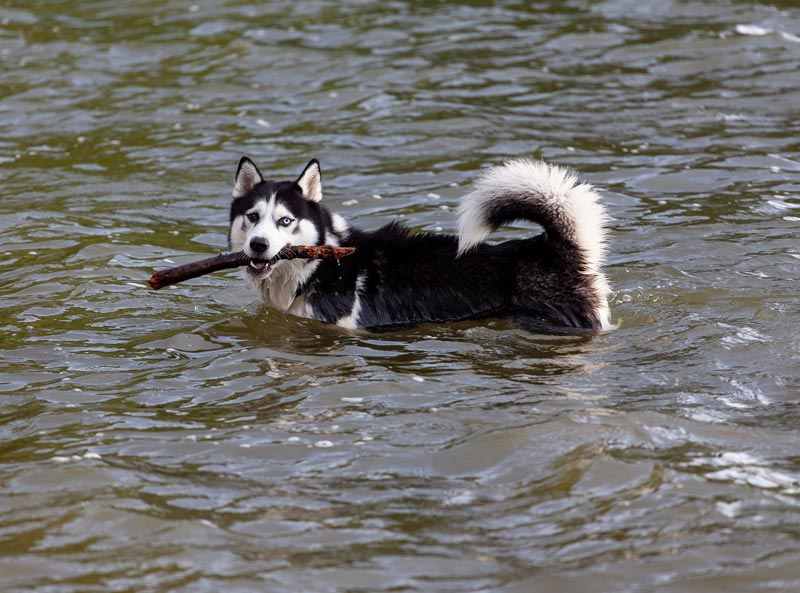
Hydration and Nutrition
Proper hydration and nutrition are crucial for your Husky’s overall health and performance during swimming activities. Consider the following factors to support their hydration and nutrition needs.
Hydrating Before and After Swimming
Make sure your Husky stays well-hydrated before, during, and after swimming. Provide access to fresh water at all times and encourage them to drink before swimming to prevent dehydration. After swimming, allow them to rest and offer them water to replenish any fluids lost during the activity.
Proper Nutrition for Enhanced Performance
A well-balanced diet is essential for your Husky’s performance during swimming. Ensure they are receiving a nutrient-rich diet that provides the necessary energy and nutrients to support their swimming activities. Consult with your veterinarian to determine the appropriate portion sizes and dietary requirements for your Husky.
Avoiding Waterborne Illnesses
Avoid swimming in stagnant or contaminated water to minimize the risk of your Husky contracting waterborne illnesses. Lakes or ponds with algae blooms, untreated swimming pools, or polluted bodies of water can pose health hazards. Stick to clean and treated swimming areas to keep your Husky safe from potential infections or illnesses.
Recognizing Signs of Fatigue
Pay close attention to your Husky’s energy levels during swimming activities. Swimming can be quite strenuous, especially for older or less experienced Huskies. Look for signs of fatigue, such as excessive panting, slowing down, or difficulty keeping their head above water. If your Husky shows signs of exhaustion, it’s time to end the swimming session and allow them to rest.
Preventing Water-Related Injuries
While swimming is generally safe for Huskies, it’s crucial to be aware of potential water-related injuries and take preventive measures to avoid them.
Ear and Eye Infections
To prevent ear and eye infections, ensure your Husky’s ears and eyes are thoroughly dried after swimming. Moisture trapped in the ears can create a favorable environment for bacterial or fungal growth. Use a soft towel or cotton balls to remove excess moisture carefully. Additionally, consider using ear drops or drops recommended by your veterinarian to help prevent infections.
Skin Irritations and Rashes
Chlorine-treated pools or certain natural bodies of water can cause skin irritations or rashes in some Huskies. Rinse your Husky’s coat with fresh water after swimming to remove any chlorine or other potential irritants. Regularly brush their coat to prevent mats or tangles that can lead to skin problems. If your Husky has sensitive skin, consult with your veterinarian to determine suitable bathing products or treatments to prevent skin issues.
Drowning Prevention
Drowning is a significant concern when it comes to swimming. Even though Huskies are generally good swimmers, accidents can happen. Always supervise your Husky closely while they are in or near water, especially in unfamiliar locations. Install a pool safety fence or a ramp to help them exit the water easily. Additionally, consider enrolling your Husky in swimming lessons or water safety training.
Avoiding Swimmer’s Tail Syndrome
Swimmer’s Tail Syndrome, also known as limber tail or cold water tail, can occur in Huskies after swimming in cold water. It is a condition where the tail becomes limp and painful due to overuse or exposure to cold water. Take precautions to prevent this condition by gradually introducing your Husky to cold water and providing a warm and comfortable environment after swimming. Limit their time in cold water and avoid strenuous activities that may strain their tail muscles.
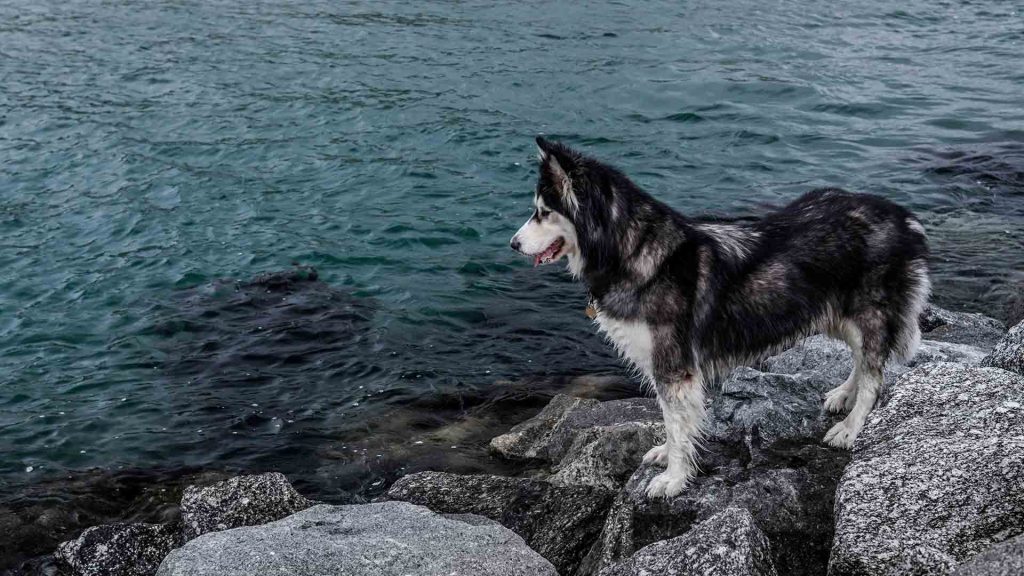
Alternatives to Swimming
While swimming is an excellent exercise option, there may be situations where swimming is not feasible or accessible. Here are some alternatives to swimming that can still provide beneficial exercise for your Husky.
Dryland Exercises for Huskies
Dryland exercises are a great way to keep your Husky active when swimming is not possible. These exercises can include walking, jogging, or running on a leash, playing fetch, or engaging in interactive games such as tug-of-war. They offer similar cardiovascular benefits and help strengthen your Husky’s muscles.
Running and Jogging
Running and jogging are excellent alternatives to swimming, especially for Huskies with high energy levels. These activities provide a vigorous workout for your Husky’s cardiovascular system, strengthen their muscles, and burn calories. However, it’s crucial to choose appropriate surfaces and monitor your Husky’s endurance to prevent injuries.
Hiking and Trekking
If you enjoy outdoor adventures, hiking and trekking can be fantastic alternatives to swimming. These activities allow your Husky to explore new environments, encounter different terrains, and engage in physical exercise. Ensure you choose dog-friendly trails and consistently monitor your Husky’s energy levels and hydration.
Mental Stimulation Activities
Swimming is not only about physical exercise but also mental stimulation. Engage your Husky in mental stimulation activities such as puzzle toys, obedience training, or scent work when swimming is not possible. Mental stimulation is key to keeping your Husky challenged and preventing boredom, which can lead to destructive behaviors.
Swimming as Rehabilitation
Swimming can also serve as a valuable rehabilitation tool, especially for Huskies recovering from injuries or those with certain health conditions. Here are some ways swimming can aid in rehabilitation.
Recovering from Injuries
Swimming provides a low-impact environment that promotes healing and recovery from various injuries. The buoyancy of water reduces stress on joints, tendons, and ligaments, enabling your Husky to rebuild strength and regain mobility. Consult with your veterinarian or a certified canine rehabilitation specialist for guidance on incorporating swimming into your Husky’s rehabilitation plan.
Strengthening Weak Muscles
Weak muscles can lead to imbalances and contribute to injuries. Swimming helps target and strengthen specific muscles that may be weak or underdeveloped in Huskies. By incorporating swimming exercises into your Husky’s rehabilitation program, you can address muscle weaknesses and promote overall muscle balance and strength.
Managing Arthritis and Joint Problems
Swimming is a gentle exercise that’s particularly beneficial for Huskies with arthritis or joint problems. The water’s buoyancy reduces joint stress and provides a low-impact workout, alleviating pain and stiffness. Regular swimming can help improve joint mobility, reduce inflammation, and enhance your Husky’s overall quality of life.
Water Therapy for Senior Huskies
As Huskies age, they may experience various age-related conditions such as muscle weakness, arthritis, or mobility limitations. Water therapy, including swimming and hydrotherapy, can be an excellent way to maintain their muscle strength, improve cardiovascular fitness, and manage age-related conditions. Consult with a veterinarian or certified therapist to design a customized water therapy program suited to your senior Husky’s needs.

Socializing Opportunities
Swimming not only provides physical exercise but also socializing opportunities that can benefit your Husky’s overall well-being. Here are some ways swimming can enhance socialization and bonding.
Group Swimming Sessions
Participate in group swimming sessions or classes specifically designed for dogs. These sessions allow your Husky to interact with other dogs and their owners in a controlled water environment. Socializing with other canines can help improve their social skills, build confidence in a group setting, and provide a fun and engaging experience.
Playing with Other Canines
Arrange playdates with other dogs who enjoy swimming. Whether at a beach, public pool, or a friend’s private pool, allowing your Husky to interact and play with other dogs while swimming can foster socialization skills, enhance their overall enjoyment, and provide a sense of camaraderie.
Bonding with the Family
Swimming with your Husky is not only a great way to exercise together but also an opportunity to strengthen your bond. The time spent swimming allows for quality interactions, trust-building, and shared experiences. It also provides an avenue for positive reinforcement and rewards, which further solidifies your relationship with your Husky.
Enhancing Social Skills
Swimming can help improve your Husky’s social skills, including their ability to interact with people and navigate different environments. By exposing them to various swimming locations and introducing them to new individuals, you can help build their confidence, reduce anxiety, and enhance their social adaptability.
Finding Suitable Swimming Locations
Choosing the right swimming location is key to ensuring a safe and enjoyable experience for your Husky. Consider the following factors when selecting a swimming spot.
Public Beaches and Pools
Public beaches and pools often have designated areas for dogs to swim. Make sure to follow any rules or regulations set by the beach or pool authorities. Choose locations that are pet-friendly, well-maintained, and free from potential hazards. Additionally, check for any restrictions or time limitations imposed on dogs in swimming areas.
Private Swimming Pools
If you have access to a private swimming pool, it can provide a convenient and controlled environment for swimming with your Husky. Ensure the pool is securely fenced and has safety measures in place to prevent any accidents. Keep chemicals balanced, maintain proper water circulation, and provide adequate shade and rest areas for your Husky.
Safety Considerations for Natural Bodies of Water
When swimming in natural bodies of water such as lakes, rivers, or ponds, ensure it is safe for your Husky. Be aware of any potential risks, such as currents, unpredictable weather conditions, or water quality concerns. Take note of any posted warnings or advisories. Stick to designated swimming areas and avoid unknown or unsafe locations.
Considering Weather and Seasons
The weather and seasons play a crucial role in choosing an appropriate swimming location for your Husky. During hot summer months, opt for shaded areas or swimming spots with freshwater sources to help keep your Husky cool and hydrated. Be cautious of extreme temperatures, storms, or icy conditions that can pose risks to your Husky’s safety.
Incorporating swimming into your Husky’s exercise routine provides numerous benefits while keeping their safety in mind. By following safety precautions, teaching proper swimming techniques, providing necessary gear, and considering hydration and nutrition, you can ensure a healthy and enjoyable swimming experience for your Husky. Whether for exercise, rehabilitation, or socialization, swimming offers a fantastic way to keep your Husky happy, healthy, and active.
